by Carly Eden Stokes | Oct 6, 2021 | Blog, News
Claudia Schreiber devoted her life to lightening the burden of others. In death, she continues to support the visually impaired, funding programs at Vision Loss Alliance of New Jersey that once helped her.
Claudia died May 26 from colon cancer at age 61, leaving behind dear family and friends, and a legsight acy that will fortify VLANJ programs for years to come.
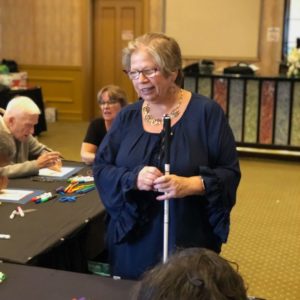
Claudia Schreiber stands in front of tables full of people smiling, holding a white cane.
“Claudia wanted to be sure programs receive the funds, because that’s where her passions lay,” said Michelle Bookbinder, Claudia’s friend of 20 years. Days before her death, the mother of two donated $10,000 to establish The Claudia Schreiber Program Fund. She asked that friends and loved ones continue to contribute to the VLANJ fund in her memory, Bookbinder said.
The Marlboro resident was an artist and entrepreneur, as well as an advocate for the visually impaired, becoming a VLANJ trustee in 2018.
“Claudia was a very active trustee from the start, always giving wise counsel,” Board of Trustees Chair Carl Augusto said. As chair of the board’s program committee, Claudia championed strong technology programs, including the Technology Learning Lab, Augusto said. “She was admired and inspired by everyone she met,” he said.
Claudia lost her vision completely in 2005, and diligently figured out ways to adapt. The advent of the iPhone “really opened up her world,” Bookbinder said. She happily shared what she learned, teaching others with vision loss useful smartphone apps and the voiceover program that could help in their daily life. Sometimes, she simply listened to their concerns.
“She really liked helping people in a personal way,” Bookbinder added.
An autoimmune disease began affecting Claudia’s vision in her early 20s, two decades before she became blind. In 2008, she began attending VLANJ, taking a class that rekindled her passion for art. The first piece she created was a self-portrait with clay. The instructor “gave me the courage to get back into my life,” Claudia said in a 2019 interview. “I fell in love with this organization.”
For three years, Claudia ran an art program for the New Jersey Blind Citizens Association in Monmouth County, volunteering her time and donating the supplies. Claudia served as president of the nonprofit’s governing board.
Claudia taught art classes and served as a peer support facilitator for the New Jersey Commission for the Blind, overseeing four support groups. People “need to learn that life isn’t over because they’ve lost their sight,” Claudia said.
For VLANJ’s virtual Dining in the Dark event during the pandemic last fall, Claudia allowed herself to be video recorded preparing a meal of tomato basil pasta with garlic bread. She showed viewers techniques for safely chopping onion and garlic and accurately measuring ingredients. The segment was supposed to run five minutes, but Claudia was so charming, they gave her 20 minutes, Augusto said.
Claudia supported VLANJ’s mission through generous annual gifts. She also donated items for silent auctions and recruited an entourage to attend VLANJ’s fundraisers. “She was one of the most giving trustees,” Augusto said.
By donating to Claudia’s fund, supporters can help Claudia’s memory live on. To contribute, contact Jennifer Singer, vice president of development and communications, at 973-627-0055, ext. 1323 or jsinger@vlanj.org.
by Carly Eden Stokes | Aug 24, 2021 | Blog
Debbie Azzarone via The Blind Vine has written about how as her vision has declined, there are things she doesn’t feel as comfortable cooking and baking as she used to feel.
Read on for some of The Blind Vine‘s tasty recipes (dessert, breakfast, even dinner!) that don’t require flipping, checking for browning, and other steps that those with low vision may want to avoid.
1. Cheesecake Flavored Ambrosia
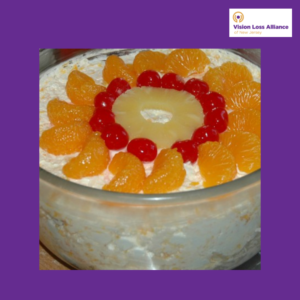
Dessert ambrosia with fruit on top sits in a bowl.
Ingredients
1 (29-ounce) can Dole fruit cocktail, drained
1 (8-ounce) can pineapple tidbits, drained
1 (11-ounce) can mandarin oranges, drained
1/2 cup maraschino cherries, drained and rinsed
1 (1-ounce) box cheesecake flavor Sugar-Free Jell-O pudding
8 ounces Daisy sour cream
3 cups Cool Whip
1 cup Jet-Puffed miniature marshmallows
Instructions
Drain all fruit. If fruit was packed in syrup, rinse in c old water and drain.
Combine fruit cocktail, pineapple, mandarin oranges and cherries in a large bowl. Sprinkle with cheesecake flavored pudding mix and stir to coat. Add in sour cream and Cool Whip and stir well.
Fold in marshmallows and chill for at least one hour before serving.
2. No-Flip Omelet
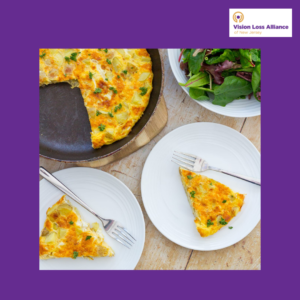
A no-flip omelet is featured in a skillet and cut up on plates.
Mix your eggs, and two tablespoons water, a little salt, etc. into a fry pan. Put all of the toppings in the eggs. Bake at 350 degrees for 10 minutes. Top with cheese until it’s melted. Fold the omelet over. Voila! A no-flip omelet.
3. Beer Crockpot Chicken
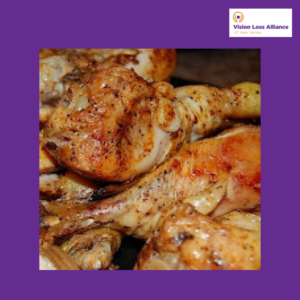
A close-up view of seasoned crock pot chicken.
You can play around with your seasonings. These are just a suggestion. You can also use fresh chicken or use frozen breasts, and either cook on low all day or cook for five hours on high. Adjust the heat according to your time on hand.
4-6 Chicken Breasts or 1 Whole or cut up Chicken
1 Can of any kind of Beer
1/2 tsp Garlic Powder
1/2 tsp Basil
1/2 tsp Paprika
1/2 tsp Black Pepper
1/2 tsp Kosher Salt
*You can use whatever spices you like
Put all ingredients into crockpot
If frozen cook on high 4-5 hours or low 8-10
If fresh cook on high 3-4 hrs. or low 7-8 hours if fresh
by Carly Eden Stokes | Aug 15, 2021 | Blog, News
For those who are blind or visually impaired, who “may not notice arrows on the floor directing foot traffic that have no texture to be felt,” such [COVID-19] safety measures “present additional obstacles for safely navigating the pandemic-era world.”
Read the full article by Well + Good about being visually impaired during the pandemic – and know that you and/or your loved ones are not alone in finding it difficult to navigate:
CLICK HERE
by Carly Eden Stokes | Jul 22, 2021 | Blog, News
Becca Meyers, a six-time Paralympic medalist who is deaf and blind, will miss the Tokyo Paralympics after being told she could not bring her Personal Care Assistant — her mother, Maria Meyers — to the Summer Games.
She called her decision to quit Team USA “gut-wrenching, and wrote: “So, in 2021, why as a disabled person am I still fighting for my rights?”
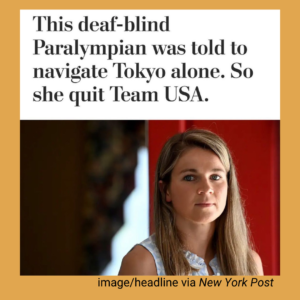
An image of Becca Meyers is depicted with the headline: “This deaf-blind Paralympian was told to navigate Tokyo alone. So she quit Team USA. Image/headline via New York Post.”
As Meyers has stated of being deaf and blind, “We must continue to fight and advocate for ourselves so that future generations can have an easier tomorrow.” Accessibility matters, inclusion matters, and disability rights matter. Read more about Becca’s story here.
by Carly Eden Stokes | Jun 20, 2021 | Blog, News
Echolocation is shared by many species, including whales and dolphins – even people can learn how to use it!
Now, new research shows that both sighted people and those who are blind can learn how to echolocate using clicking noise, either from one’s own mouth, footsteps, or walking cane taps, after just 10 weeks of training.
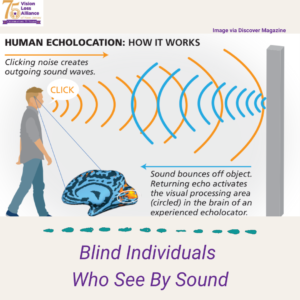
The VLANJ logo and an image via Discover Magazine depicting how human echolocation works is featured, with text that reads: “Human Echolocation: How It Works. Clicking noise creates ongoing sound waves. Sound bounces off object. Returning echo activates the visual processing area (circled) in the brain of an experienced echolocator.” Text below reads: “Blind Individuals Who See By Sound.”






